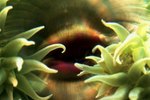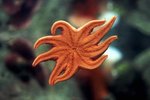
The colorful, five-armed creature called a starfish is not a fish at all, but a member of the Echinodermata family along with sea cucumbers and sea urchins. These sea animals are commonly found in tidal habitats, although some species also live in deeper ocean. Starfish have a unique form of digestion in the animal kingdom and a water-vascular system that allows the animal to breathe.
Diet
Starfish are carnivores. They eat animals such as barnacles, sea anemones, gastropods, sea urchins, sea snails and shellfish. Crabs, dead fish and even other starfish supplement the starfish's diet. Starfish grasp prey using the suction cups at the end of the tube feet on the underside of their arms and use the suction to pull apart the shell to get to the meat inside.
Feeding
The starfish does not consume prey. Rather, it brings the prey to the mouth located near the center of its body. The starfish then pushes its cardiac stomach out of its mouth into the food. Digestive enzymes are released, liquifying the food so the starfish can sip the liquid into its stomach. Once the prey is ingested, the starfish retracts its stomach back into its body.
Digestion
Once the prey is sipped in through the cardiac stomach, it passes into the pyloric stomach. From there, the nutrients travel down the pyloric ducts to the pyloric ceca at the end of each arm where nutrients are absorbed and stored. Waste travels from the pyloric stomach through a short intestine and is excreted through the anus located at the top of the starfish.
Respiration
Respiration or gas exchange occurs in two locations on a starfish. The first location is through the thin skin on the ends of the tube feet. Gas exchange also occurs in the dermal gills or papulae. These gills are lined with cilia that move to produce a current. The current brings fresh water so the starfish can absorb oxygen and freshens the surrounding water where the starfish may have just excreted carbon dioxide.
References
Photo Credits
-
Jupiterimages/Photos.com/Getty Images
Writer Bio
Maureen Malone started writing in 2008. She writes articles for business promotion and informational articles on various websites. Malone has a Bachelor of Science in technical management with an emphasis in biology from DeVry University.




